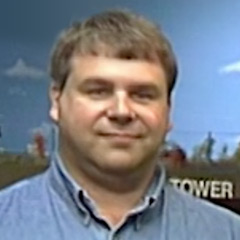
Railway Routing on the Ohio Interchange System
Bruce CarpenterBruce Carpenter had virtually given up the hobby of model railroading back in the 1990s when he got a jolt of inspiration that lead to the design and building of his BNSF layout. He tells MRA's Allen Keller that he'd participated in clubs and even tried modeling alone, but had lost all interest and had thinned his collection to almost nothing when he and a friend received an invite Ohio Interchange group in Springfield, OH. What he learned from that session about railway routing provided a spark - and a plan.
Today, Bruce operates up to 50 trains and 900 cars in one 4-hour session. And he credits a unique card railway routing system that is easy for operators to learn and use and keeps his railroad operating efficiently, especially given the fact he seven different railroads are allowed to interact and interchange on his layout.
Bruce gives a closeup view of his color-coded card railway routing system that allows cars to be routed off his system and returned.
The Ohio interchange group got you started in building the layout. Who or what is this? Well, it was a group that started in Springfield, Ohio and they had a large layout similar to this that they operated on. And I was invited to partake in that, a friend and I. So we traveled down, we didn't know what to expect, but immediately, the first time we were there, I knew I'd finally found what I was looking for in a hobby.
I tried the club routine, I tried modeling something on my own and I was basically out of the hobby when I was invited down here. I had about seven freight cars left and I basically just thinned my collection down to next to nothing because I just I'd really lost interest and I just did not, nothing seemed to click Oh. until I hooked up with these guys. And from there, we've just taken it and we've just grown by leaps and bounds. You helped develop a car-routing system that involves a number of model railroads.
Tell me about that. I'm going to demonstrate the actual routing of an empty box car off of the BNSF between Chicago and Kansas City, my model portion, and how that car will travel empty out west to be loaded with lumber and then it will show the automatic routing of it coming back to my model portion and being delivered. This is the car I've selected to route out from my railroad out west to California to pick up a load of lumber. This car card has all the vital information that matches this car. What type it is, the reporting marks, the car number.
There's a place for special features. And if I wanted it to come back to someplace special, I could write in "Empty To", the owner and when the last time it was serviced. We came up with this card system to enable us to have seven different railroads interact together. The gray dot here signifies the color of my railroad, which is gray. The color of the railroad we're sending it to, which is a Union Pacific line, is yellow.
And this is the tag that will go in this that will route the car out to be loaded. Using an industrial guide from the Union Pacific, I find there's a warehouse or lumber warehouse located on that railroad. I simply fill out the tag, in this case MDW. This is the yellow tag, goes in the slot. Now that car is routed and ready to be placed in a train with other yellow cars traveling to the Union Pacific westbound.
Once the car arrives on the Union Pacific and is switched in to the industry and loaded, the owner of that railroad removes the tag, reveals this gray color. The car is automatically routed back a month, maybe two, later and it automatically comes back to me.

Share tips, start a discussion or ask other students a question. If you have a question for an expert, please click here.
Already a member? Sign in
No Responses to “Railway Routing on the Ohio Interchange System”